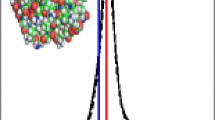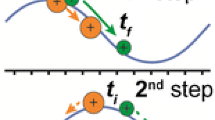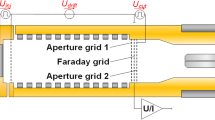Abstract
Ion mobility mass spectrometry (IM-MS) can be used to differentiate and identify isobaric ions. To improve IM-MS resolution, the second generation of traveling wave ion mobility (TWIM) technology was launched. There were reports showing ions were heated up by TWIM. With higher ion energy, it could alter the conformation of larger ions or MS/MS experiments. To monitor the energy exchange relating to the TWIM process, the combined use of thermometer ions with unique molecular structure and theoretical calculations to determine the effective temperature of ions had been explored. In this report, the use of a simple experimental approach to estimate the variation on the ion energy that result from changing a TWIM parameter setting is demonstrated. The approach aims to achieve the same percentage of ion dissociation in a collision cell, which is part of the original instrument and located at the exit of TWIM cell. Similar to the traditional MS/MS experiments, the same level of ion dissociation could be achieved by adjusting the electrical potential that was applied to the collision cell. The higher the ion energy after the TWIM separation, the lower the electrical potential was required to achieve the same level of ion dissociation. Together with the information on the number of electrical charge in the selected ion, the difference in the required electrical potentials could be converted into electron volt of ion energy that resulted from changing the TWIM parameter setting. The results showed ion energy could be changed 1–9 eV when the parameter of TWIM was adjusted.



Similar content being viewed by others
References
Dwivedi P, Puzon G, Tam M, Langlais D, Jackson S, Kaplan K, Siems WF, Schultz AJ, Xun L, Woods A, Hill HH (2010) Metabolic profiling of Escherichia coli by ion mobility mass spectrometry with MALDI ion source. J Mass Spectrom 45(12):1383–1393
Hofmann J, Hahm HS, Seeberger PH, Pagel K (2015) Identification of carbohydrate anomers using ion mobility-mass spectrometry. Nature 526(7572):241–244
Li H, Bendiak B, Siems WF, Gang DR, Hill HH (2015) Determining the isomeric heterogeneity of neutral oligosaccharide-alditols of bovine submaxillary mucin using negative ion traveling wave ion mobility mass spectrometry. Anal Chem 87(4):2228–2235
Jeanne Dit Fouque K, Afonso C, Zirah S, Hegemann JD, Zimmermann M, Marahiel MA, Rebuffat S, Lavanant H (2015) Ion mobility-mass spectrometry of lasso peptides: signature of a rotaxane topology. Anal Chem 87(2):1166–1172
Allen SJ, Giles K, Gilbert T, Bush MF (2016) Ion mobility mass spectrometry of peptide, protein, and protein complex ions using a radio-frequency confining drift cell. Analyst 141(3):884–891
Leijdekkers AG, Huang JH, Bakx EJ, Gruppen H, Schols HA (2016) Identification of novel isomeric pectic oligosaccharides using hydrophilic interaction chromatography coupled to traveling-wave ion mobility mass spectrometry. Carbohydr Res 404:1
May JC, Goodwin CR, Lareau NM, Leaptrot KL, Morris CB, Kurulugama RT, Mordehai A, Klein C, Barry W, Darland E, Overney G, Imatani K, Stafford GC, Fjeldsted JC, McLean JA (2017) Conformational ordering of biomolecules in the gas phase: nitrogen collision cross sections measured on a prototype high resolution drift tube ion mobility-mass spectrometer. Anal Chem 86:2107
Marchand A, Livet S, Rosu F, Gabelica V (2017) Drift tube ion mobility: how to reconstruct collision cross section distributions from arrival time distributions? Anal Chem 89(23):12674–12681
Campbell JL, Le Blanc JC, Kibbey RG (2015) Differential mobility spectrometry: a valuable technology for analyzing challenging biological samples. Bioanalysis 7(7):853–856
Zhong Y, Hyung SJ, Ruotolo BT (2011) Characterizing the resolution and accuracy of a second secondgeneration traveling-wave ion mobility separator for biomolecular ions. Analyst 136(17):3534–3541
Fernandez-Lima F, Kaplan DA, Suetering J, Park MA (2011) Gas-phase separation using a trapped ion mobility spectrometer. Int J Ion Mobil Spectrom 14(2-3):93–98
Giles K, Wildgoose JL, Langridge DJ, Campuzano I (2010) Metabolic profiling of human blood by high resolution Ion Mobility Mass Spectrometry (IM-MS). Int J Mass Spectrom 298(1-3):10–16
Shvartsburg AA, Smith RD (2008) Fundamentals of traveling wave ion mobility spectrometry. Anal Chem 80(24):9689–9699
D'Atri V, Causon T, Hernandez-Alba O, Mutabazi A, Veuthey JL, Cianferani S, Guillarme D (2018) Adding a new separation dimension to MS and LC-MS: what is the utility of ion mobility spectrometry? J Sep Sci 41(1):20–67
Morsa D, Gabelica V, De Pauw E (2011) Effective temperature of ions in traveling wave ion mobility spectrometry. Anal Chem 83(14):5775–5782
Merenbloom SI, Flick TG, Williams ER (2012) How hot are your ions in TWAVE ion mobility spectrometry?. J Am Soc Mass Spectrom 23(3):553–562
Giles K, Pringle SD, Worthington KR, Little D, Wildgoose JL, Bateman RH (2004) Applications of a travelling wave-based radio-frequency-only stacked ring ion guide. Rapid Commun Mass Spectrom 18(20):2401–2414
May JC, McLean JA (2013) The influence of drift gas composition on the separation mechanism in traveling wave ion mobility spectrometry: insight from electrodynamic simulations. Int J Ion Mobil Spectrom 16(2):85–94
Acknowledgements
J.M. wishes to acknowledge the supports received from NSF GK-12 program and Burroughs Wellcome Fund. N.C. wishes to acknowledge the support from an internal research grant. All other financial and technical supports were provided by the Chemistry and Biochemistry Department at UNCG.
Author information
Authors and Affiliations
Corresponding author
Ethics declarations
Conflict of interest
There are no conflicts to declare.
Rights and permissions
About this article
Cite this article
Mwangi, J.N., Todd, D.A. & Chiu, N.H.L. Evaluating the variation of ion energy under different parameter settings in traveling wave ion mobility mass spectrometry. Int. J. Ion Mobil. Spec. 21, 81–86 (2018). https://doi.org/10.1007/s12127-018-0238-y
Received:
Accepted:
Published:
Issue Date:
DOI: https://doi.org/10.1007/s12127-018-0238-y




